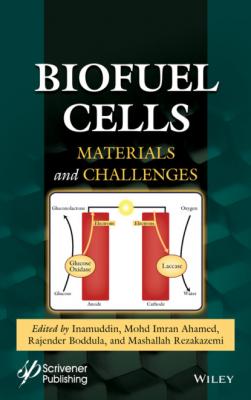Biofuel Cells. Группа авторов
Читать онлайн.| Название | Biofuel Cells |
|---|---|
| Автор произведения | Группа авторов |
| Жанр | Физика |
| Серия | |
| Издательство | Физика |
| Год выпуска | 0 |
| isbn | 9781119725053 |
Figure 2.2 Photograph of a snail with implanted biocatalytic electrodes (Adapted from Ref. [29], with permission; Copyright American Chemical Society, 2012).
In the future, with the idea of being able to implantable EFCs to humans and evaluate blood sugar for mini/micro devices, EFCs have been tested with more advanced living creatures such as mammals. A miniature EFC system (skin-worn biofuel cell) for power production from ear of rabbit was made of a needle anode and a gas diffusion cathode for using oxygen in the air. The needle electrode substrate was coated with a biocompatible polymer (2-methacryloyloxyethyl phosphorylcholine) defined as antibiofouling agent to prevent blood clotting on the electrode surface. The needle electrode was designed for easy access to blood sugar and insterted in a blood vessel in the ear of rabbit for glucose oxidation. The polymer coated needle electrode was reported to be effective in stabilizing the output power. The needle anode without polymer was lost almost 40% of its power. The power generation was reported to be 0.42 μW at a cell potential of 0.56 V [32]. EFCs (mediator-, cofactor-, and membrane-less) designed with 3D nanostructured micro-scale gold electrodes were operated in cerebrospinal fluid and a rat brain. The implantation photograph of micro bioelectrodes into the rat cortex was shown in Figure 2.3a. The maximum power density was reported to be 2 μW cm−2 in vivo and 7 μW cm−2 in vitro at a cell potantial of 0.4 V by using in vivo glucose [23]. Another glucose based EFC was implanted into a rat’s abdominal cavity and produced average OCV of 0.57 V. In this study, it was reported that the power output (38.7 μW) produced by EFC could be sufficient to operate a digital thermometer or a light-emitting diode (LED). Even after 110 days of implantation, inflammation or rejection was not detected in the mammalian body except surrounded by adipose tissue [33]. Miniaturized EFC placed in the left jugular vein of the Wistar rat using a catheter, was tested with glucose in rat blood under physiological medium. A photograph of the catheter implanted into the jugular vein of rat was given in Figure 2.3b. 0.125 V OCV and 95 μW cm−2 power density were calculated at cell potential of 0.08 V from the EFC with 24 h operation [34].
Figure 2.3 (a) Photograph of the implantation of microbioelectrodes into the rat brain, (b) a photograph of the catheter implanted into the jugular vein of rat and an optical microscope image of the flexible carbon fiber microelectrodes ((a) is adapted from Ref. [23], with permission; Springer Nature, (b) is adapted from Ref. [34], with permission; Royal Society of Chemistry).
There have been few reports on implantable MFCs. A continuous flow single-chamber MFC without membrane was developed to supply power in human transverse colon. This device utilized intestinal contents and microbial community in the colon, and generated a power density of 11.73 mW/m2 at an external load of 100 Ω. The MFC operated stably, but pH and ORP values dropped significantly. The authors stated that further works focused on the performance tests, microbial distrubition and the effect on human body should be investigated [35]. Another MFC was implanted in human large intestine and placed in transverse colon. The device consisted of two Plexiglas chambers, and each chamber had a rectangular dimensions of 10 × 25 × 10 cm. The anode and the cathode was made up with activated carbon fiber and carbon paper including Pt catalyst, respectively. The MFC generated electricity stably for 200 h after two months of operation, with a maximum power density of 73.3 mW m−2 [36]. It is obvious that the reported MFC devices are large in size, the long-term effects on the human body and how electrical connection is provided are uncertain [18]. Luckily, EFCs can be miniaturized, while an MFC can not be miniaturized sufficiently for implantation. This is the major reason fort he development of implantable MFC technology to slow down.
2.1.2 Wearable BFCs
By considering the major drawbacks of implantable BFCs, in recent years there is a tendency for developing wearable devices which are miniaturized and integrated easily to human body without surgery. In addition, the difficulties in implantable EFCs applications have led researchers to wearable fuel cell technology and, consequently, to investigate physiological fluids as alternative to blood, for example urine, tears, sweat, saliva and transdermal fluid. These fluids are easily available and do not require blood draw or implantations for testing [37]. It can be thought as conventional batteries can be used for wearable electronics, however they are unsuitable for this application since they are rigid and toxic [38]. Although, EFCs are commonly used, MFCs have also been developed for wearable electronics. One of the drawback of an MFC is that cytotoxicity
